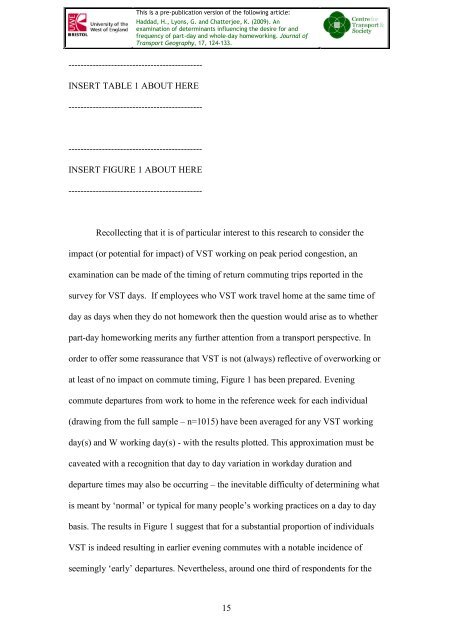Haddad, H. , Lyons, G. and Chatterjee, K. (2009) - UWE Research ...
Haddad, H. , Lyons, G. and Chatterjee, K. (2009) - UWE Research ...
Haddad, H. , Lyons, G. and Chatterjee, K. (2009) - UWE Research ...
Create successful ePaper yourself
Turn your PDF publications into a flip-book with our unique Google optimized e-Paper software.
This is a pre-publication version of the following article:<br />
<strong>Haddad</strong>, H., <strong>Lyons</strong>, G. <strong>and</strong> <strong>Chatterjee</strong>, K. (<strong>2009</strong>). An<br />
examination of determinants influencing the desire for <strong>and</strong><br />
frequency of part-day <strong>and</strong> whole-day homeworking. Journal of<br />
Transport Geography, 17, 124-133.<br />
--------------------------------------------<br />
INSERT TABLE 1 ABOUT HERE<br />
--------------------------------------------<br />
--------------------------------------------<br />
INSERT FIGURE 1 ABOUT HERE<br />
--------------------------------------------<br />
Recollecting that it is of particular interest to this research to consider the<br />
impact (or potential for impact) of VST working on peak period congestion, an<br />
examination can be made of the timing of return commuting trips reported in the<br />
survey for VST days. If employees who VST work travel home at the same time of<br />
day as days when they do not homework then the question would arise as to whether<br />
part-day homeworking merits any further attention from a transport perspective. In<br />
order to offer some reassurance that VST is not (always) reflective of overworking or<br />
at least of no impact on commute timing, Figure 1 has been prepared. Evening<br />
commute departures from work to home in the reference week for each individual<br />
(drawing from the full sample – n=1015) have been averaged for any VST working<br />
day(s) <strong>and</strong> W working day(s) - with the results plotted. This approximation must be<br />
caveated with a recognition that day to day variation in workday duration <strong>and</strong><br />
departure times may also be occurring – the inevitable difficulty of determining what<br />
is meant by „normal‟ or typical for many people‟s working practices on a day to day<br />
basis. The results in Figure 1 suggest that for a substantial proportion of individuals<br />
VST is indeed resulting in earlier evening commutes with a notable incidence of<br />
seemingly „early‟ departures. Nevertheless, around one third of respondents for the<br />
15

















